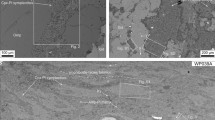Abstract.
Exposed, subduction-related magmatic arcs commonly include sections of ultramafic plutonic rocks that are composed of dunite, wehrlite, and pyroxenite. In this experimental study we examined the effects of variable H2O concentration on the phase proportions and compositions of igneous pyroxenites and related ultramafic plutonic rocks. Igneous crystallization experiments simulated natural, arc magma compositions at 1.2 GPa, corresponding to conditions of the arc lower crust. Increasing H2O concentration in the liquid changes the crystallization sequence. Low H2O concentration in the liquid stabilizes plagioclase earlier than garnet and amphibole while derivative liquids remain quartz normative. Higher H2O contents (>3%) suppress plagioclase and lead to crystallization of amphibole and garnet thereby producing derivative corundum normative andesite liquids. The experiments show that alumina in the liquid correlates positively with Al in pyroxene, as long as no major aluminous phase crystallizes. Extrapolation of this correlation to natural pyroxenites in the Talkeetna and Kohistan arc sections indicates that clinopyroxenes with low Ca-Tschermaks component represent near-liquidus phases of primitive, Si-rich hydrous magmas.
Density calculations on the residual solid assemblages indicate that ultramafic plutonic rocks are always denser than upper mantle rocks in the order of 0.05 to 0.20 g/cm3. The combination of high pressure and high H2O concentration in the liquid suppresses plagioclase crystallization, so that ultramafic plutonic rocks form over a significant proportion of the crystallization interval (up to 50% crystallization of ultramafic rocks from initial, mantle-derived liquids). This suggests that in subduction-related magmatic arcs the seismic Moho might be shallower than the petrologic crust/mantle transition. It is therefore possible that calculations based on seismic data have overestimated the normative plagioclase content (e.g., SiO2, Al2O3) of igneous crust in arcs.
Similar content being viewed by others
Author information
Authors and Affiliations
Additional information
Electronic Publication
Rights and permissions
About this article
Cite this article
Müntener, O., Kelemen, P.B. & Grove, T.L. The role of H2O during crystallization of primitive arc magmas under uppermost mantle conditions and genesis of igneous pyroxenites: an experimental study. Contrib Mineral Petrol 141, 643–658 (2001). https://doi.org/10.1007/s004100100266
Received:
Accepted:
Issue Date:
DOI: https://doi.org/10.1007/s004100100266




